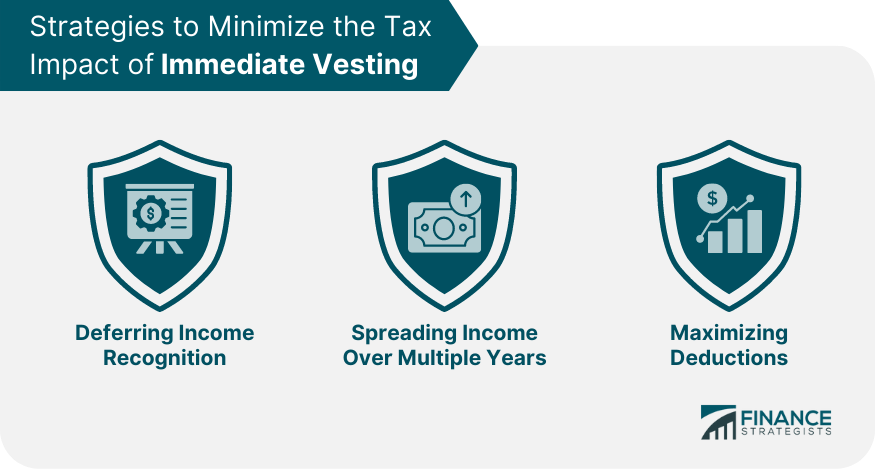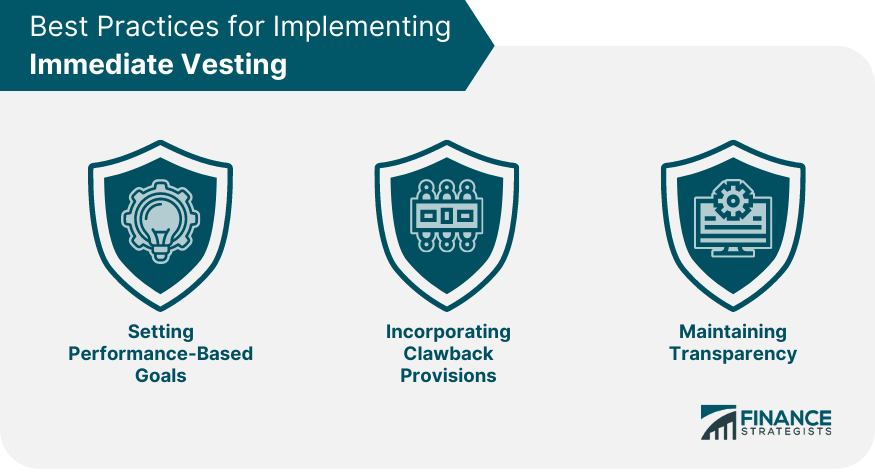Immediate vesting is a financial concept that refers to the immediate transfer of full ownership rights to an employee or investor for assets such as stock options, retirement plans, or restricted stock units (RSUs). This contrasts with other vesting schedules where ownership rights are granted gradually over a predefined period. The primary purpose of immediate vesting is to incentivize employees or investors by granting them immediate access to their financial benefits. This can help improve employee retention, encourage long-term commitment, and align stakeholders' interests. Immediate vesting differs from other vesting schedules, such as graded vesting, cliff vesting, and performance-based vesting, in the speed at which ownership rights are granted. This section will further explore these differences and the factors affecting the choice of the vesting schedule. Immediate vesting in employee stock options allows employees to exercise their options and potentially profit from any increase in the company's stock price right away. This can strongly incentivize employees to join and stay with the company. Employers can attract top talent and motivate employees by offering immediate vesting stock options. This strategy can also help to retain key employees during critical periods or during company transitions. The primary drawback of immediate vesting is the possibility of employees leaving the company shortly after receiving the full value of their stock options. This can result in high employee turnover and increased costs for hiring and training new employees. In 401(k) plans, immediate vesting may apply to employee contributions, employer matching contributions, or both. Immediate vesting can encourage employees to participate in the plan and increase their retirement savings. Immediate vesting in profit-sharing plans allows employees to receive and control their share of company profits immediately. This can lead to increased motivation and loyalty among employees. In defined benefit pension plans, immediate vesting guarantees employees their full pension benefits upon meeting specific requirements, such as reaching a certain age or years of service. This helps retain experienced employees and foster long-term commitment. Immediate vesting in retirement plans can positively impact employee retention and motivation by granting employees access to their benefits sooner. This can lead to increased loyalty, job satisfaction, and financial security. Employees with immediate vesting RSUs can sell or transfer their shares immediately after they are granted, providing instant financial benefits and flexibility. Employers can use immediate vesting RSUs to attract and retain top talent, while also aligning employee interests with the company's performance and shareholder value. Employees with immediate vesting RSUs may face higher taxes due to the immediate recognition of income. Tax planning strategies can help employees manage these tax implications. The Internal Revenue Code (IRC) sets specific rules and requirements for taxing immediate vesting benefits. Compliance with these provisions is essential for both employees and employers. Employee Retirement Income Security Act (ERISA) governs retirement plans, including immediate vesting provisions, to protect employee benefits. Employers must adhere to ERISA requirements when implementing immediate vesting in retirement plans. The Securities and Exchange Commission (SEC) regulates stock options and RSUs, including immediate vesting provisions. Companies must comply with SEC rules to ensure proper disclosure, reporting, and compliance when offering immediate vesting benefits to employees. The European Union sets guidelines and directives for member countries to regulate employee benefits, including immediate vesting provisions. Companies operating within the EU must comply with these directives. Other jurisdictions may have their own regulations governing immediate vesting. Companies need to understand and comply with the relevant rules in each country where they operate. Employers must comply with reporting requirements to ensure proper administration and management of immediate vesting benefits. This includes accurate record-keeping, timely reporting, and maintaining transparency with employees and regulatory authorities. Employees with immediate vesting benefits may face higher income taxes due to the immediate recognition of income. Proper tax planning can help employees manage these tax implications. Employers may be able to claim tax deductions for compensation expenses related to immediate vesting benefits. Compliance with tax regulations is essential for maximizing these deductions. Employees with immediate vesting stock options or RSUs may be subject to capital gains taxes if they sell their shares at a profit. Understanding the applicable capital gains tax rules can help employees make informed decisions about selling their shares. Immediate vesting benefits may impact employee and employer payroll taxes. Employers should ensure accurate calculation and timely payment of these taxes to avoid penalties. Employees can use tax planning strategies, such as deferring income recognition, spreading income over multiple years, or maximizing deductions, to help manage the tax implications of immediate vesting benefits. Immediate vesting can be a significant component of executive compensation packages, helping to attract and retain top talent while aligning their interests with shareholders. Immediate vesting can help align the interests of management and shareholders by incentivizing management to improve the company's performance and shareholder value. Immediate vesting may create potential conflicts of interest if executives focus solely on short-term gains rather than long-term success. Implementing appropriate checks and balances can help mitigate these risks. Companies should consider best practices, such as setting performance-based goals, incorporating clawback provisions, and maintaining transparency when implementing immediate vesting to ensure fairness and effectiveness. Graded vesting involves the gradual transfer of ownership rights over a predetermined period. This approach can provide a balance between employee retention and incentivization but may offer different immediate financial benefits than immediate vesting. After a specific service period, cliff vesting grants ownership rights in a single installment. This approach can be useful for retaining employees for a minimum period but may result in high employee turnover after the vesting period ends. Performance-based vesting ties ownership rights to the achievement of specific performance goals. This approach can help align employee incentives with the company's performance but may provide a different level of financial security than immediate vesting. Companies should consider factors such as employee retention, motivation, financial performance, and regulatory compliance when choosing the appropriate vesting schedule. Immediate vesting refers to the transfer of full ownership rights to an employee or investor for assets such as stock options, retirement plans, or restricted stock units (RSUs). Immediate vesting incentivizes employees by granting them immediate access to their financial benefits and can positively impact employee retention and motivation. However, companies need to consider potential drawbacks, such as increased employee turnover, and comply with legal and regulatory frameworks, including the Internal Revenue Code (IRC), Employee Retirement Income Security Act (ERISA), and Securities and Exchange Commission (SEC) rules. Proper tax planning strategies can help employees manage the tax implications of immediate vesting benefits. Companies should also consider best practices, such as setting performance-based goals and incorporating clawback provisions, when implementing immediate vesting. Graded vesting, cliff vesting, and performance-based vesting are alternative vesting schedules that companies can choose based on factors such as employee retention, motivation, financial performance, and regulatory compliance.What Is Immediate Vesting?
Immediate Vesting in Various Financial Instruments
Employee Stock Options
Advantages for Employees
Advantages for Employers
Potential Drawbacks
Retirement Plans and Immediate Vesting
401(k) Plans
Profit-Sharing Plans
Defined Benefit Pension Plans
Impact on Employee Retention and Motivation
Restricted Stock Units (RSUs)
Advantages for Employees
Advantages for Employers
Tax Implications
Legal and Regulatory Framework for Immediate Vesting
U.S. Regulations
Internal Revenue Code (IRC) Provisions
Employee Retirement Income Security Act (ERISA)
Securities and Exchange Commission (SEC) Rules
International Regulations
European Union Directives
Other Major Jurisdictions
Compliance and Reporting Requirements
Tax Implications of Immediate Vesting
Income Tax Treatment
Employees
Employers
Capital Gains Tax Considerations
Payroll Taxes
Tax Planning Strategies

Immediate Vesting and Corporate Governance
Impact on Executive Compensation
Alignment of Interests Between Management and Shareholders
Potential Conflicts of Interest
Best Practices for Implementing Immediate Vesting

Immediate Vesting vs. Other Vesting Schedules
Graded Vesting
Cliff Vesting
Performance-Based Vesting
Factors Affecting the Choice of Vesting Schedule
Conclusion
Immediate Vesting FAQs
Immediate vesting refers to the right of an employee to own employer-contributed benefits or assets, such as a retirement plan or stock options, without any delay or waiting period.
In immediate vesting, the employee has complete ownership and control of the benefits or assets the employer provides from the moment they are given. The employee is not required to work for a specific period or meet any other criteria to gain access to these benefits.
Immediate vesting allows employees to have full control over employer-provided benefits, which can help them achieve their financial goals. It also eliminates the risk of losing out on these benefits due to unforeseen circumstances like job loss or company bankruptcy.
Employers have the option to choose immediate vesting or opt for a graded vesting schedule where the employee's right to the benefits increases over a period of time. However, some retirement plans like 401(k)s have mandatory immediate vesting provisions.
Immediate vesting may increase the administrative burden on the employer as they need to keep track of the benefits and ensure they are distributed correctly. It may also lead to increased costs if the employee leaves the company immediately after receiving the benefits.
True Tamplin is a published author, public speaker, CEO of UpDigital, and founder of Finance Strategists.
True is a Certified Educator in Personal Finance (CEPF®), author of The Handy Financial Ratios Guide, a member of the Society for Advancing Business Editing and Writing, contributes to his financial education site, Finance Strategists, and has spoken to various financial communities such as the CFA Institute, as well as university students like his Alma mater, Biola University, where he received a bachelor of science in business and data analytics.
To learn more about True, visit his personal website or view his author profiles on Amazon, Nasdaq and Forbes.











